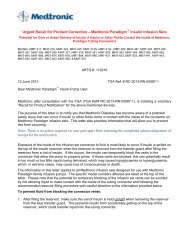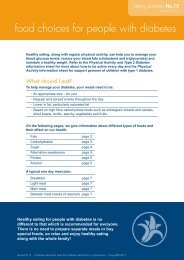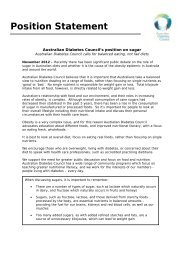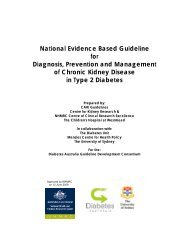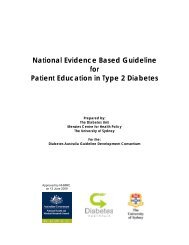Tamil - Australian Diabetes Council
Tamil - Australian Diabetes Council
Tamil - Australian Diabetes Council
- No tags were found...
Create successful ePaper yourself
Turn your PDF publications into a flip-book with our unique Google optimized e-Paper software.
Physical activity - continued<br />
What about Resistance Training<br />
You should also aim to include some kind of weight or resistance training during the week.<br />
Resistance training means any exercise or activity where you use your body to lift something<br />
or to work against a weight, force or gravity. Resistance training is great for helping you to<br />
keep active and independent for longer and has additional benefits for people with diabetes.<br />
Resistance training can:<br />
• Improve the way your body uses and stores insulin<br />
• Increases your muscle mass. This increases how much energy you burn which helps with<br />
weight loss/ management and improving blood glucose control<br />
• Decrease your risk of falling and the risk of fractures<br />
• Improve strength, power, balance and coordination.<br />
How much resistance training<br />
do I need to be doing for good<br />
health<br />
• Try to lift weights (e.g. cans of<br />
food, hand weights) two - three<br />
times a week<br />
• Include exercises that target<br />
all of your large muscle groups<br />
including your arms and legs<br />
• Aim to do each exercise eight -<br />
twelve times (repetitions), and perform two - three lots (sets) of each exercise<br />
• Start at a light weight till you learn the correct technique. After you have mastered this<br />
weight, try lifting a heavier weight<br />
• Ideally, aim to lift a weight that only allows you to do eight - twelve repetitions each time.<br />
Precautions to take before initiating an exercise program:<br />
If you plan to start an exercise program for the first time, or you are doing something new,<br />
visit your doctor for medical clearance before you begin.<br />
It is also important to understand how your medications work together with physical<br />
activity. Exercise works like insulin and lowers your blood glucose levels (sugar). In people<br />
who are taking insulin or some oral medications the combined effect with exercise can<br />
cause hypoglycemia. To avoid this, it is important to regularly test your blood glucose levels<br />
(sugars) before, sometimes during, immediately after and again a couple of hours after<br />
exercise, so you understand how your body responds to different activities. If you find that<br />
your blood glucose is falling too low, you may need to alter your diabetes medication or eat<br />
extra carbohydrates to account for this effect. However, consult with your doctor, diabetes<br />
educator or dietitian before making these changes.<br />
There are also some times when you should avoid exercise; if your blood glucose levels<br />
(sugars) are above 15 mmol/L, if you are feeling unwell or lightheaded (dizzy) or if you are<br />
unsure how to perform an exercise correctly.<br />
Most important!<br />
Enjoy the activities you chose. Be active in as many ways as you can, every day and remember<br />
you don’t have to take it seriously, just regularly.<br />
Always speak with your doctor before beginning a new physical activity program. If you<br />
require more guidance or advice about exercising with diabetes, speak with an accredited<br />
exercise physiologist.<br />
50






